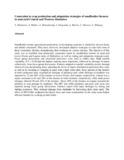Please use this identifier to cite or link to this item:
https://cris.library.msu.ac.zw//handle/11408/3022Full metadata record
| DC Field | Value | Language |
|---|---|---|
| dc.contributor.author | Makuvaro, V. | - |
| dc.contributor.author | Walker, S. | - |
| dc.contributor.author | Munodawafa, A. | - |
| dc.contributor.author | Chagonda, I. | - |
| dc.contributor.author | Masere, Tirivashe P. | - |
| dc.contributor.author | Murewi, C. | - |
| dc.contributor.author | Mubaya, C. | - |
| dc.date.accessioned | 2018-05-06T13:59:47Z | - |
| dc.date.available | 2018-05-06T13:59:47Z | - |
| dc.date.issued | 2017 | - |
| dc.identifier.issn | 1021-9730 | - |
| dc.identifier.uri | https://www.ajol.info/index.php/acsj/article/view/156996/146606 | - |
| dc.identifier.uri | http://hdl.handle.net/11408/3022 | - |
| dc.description.abstract | Smallholder farmer agricultural productivity in developing countries is limited by diverse biotic and abiotic constraints. They have, however, developed adaptive strategies to cope with some of these constraints, thereby strengthening their resilience to various stresses. The objective of this study was to establish crop production constraints faced by smallholder farmers in semi-arid Lower Gweru and Lupane areas of Zimbabwe, as well as coping and adaptation strategies used. Focus group discussions and structured interviews were used to collect data. High rainfall variability (CV = 0.30) had the highest ranking (most important), followed by shortage of inputs collectively, from focus group discussions. Farmers adapted to rainfall variability mostly through choice of crop and planting dates, adjusting the levels of inputs (fertiliser in particular) they used, as well as by resorting to cropping in areas with a high water table. Sixty percent of the farmers in both communal areas experienced shortage of planting seed, while shortage of fertiliser was reported by 75 and 30% of the farmers in Lower Gweru and Lupane, respectively. Labour was a major constraint to 65 and 20% of the farmers in both locations, respectively; while draft power shortage affected 50 and 25% of the farmers. About 50% of the farmers in Lupane reported the problem of crop damage by elephants. The HIV and AIDs pandemic and poor soils were also reported during focus group discussions. Farmers coped with input shortages by hiring and sharing resources. They reduced damage from elephants by harvesting their crops early. The effect of HIV/AIDs weakened the labour force and some communities in the study areas helped affected families by working in their fields | en_US |
| dc.language.iso | en | en_US |
| dc.publisher | African Crop Science Society | en_US |
| dc.relation.ispartofseries | African Crop Science Journal;Vol. 25, No. 2, p. 221-235 | - |
| dc.subject | Fertilisers | en_US |
| dc.subject | HIV | en_US |
| dc.subject | Labour | en_US |
| dc.subject | Seeds | en_US |
| dc.title | Constraints to crop production and adaptation strategies of smallholder farmers in semi-arid Central and Western Zimbabwe. | en_US |
| dc.type | Article | en_US |
| item.cerifentitytype | Publications | - |
| item.grantfulltext | open | - |
| item.fulltext | With Fulltext | - |
| item.openairecristype | http://purl.org/coar/resource_type/c_18cf | - |
| item.languageiso639-1 | en | - |
| item.openairetype | Article | - |
| Appears in Collections: | Research Papers | |
Files in This Item:
| File | Description | Size | Format | |
|---|---|---|---|---|
| Constraints to crop production and adaptation strategies of smallholder farmers in semi.pdf | Abstract | 29.8 kB | Adobe PDF |  View/Open |
Page view(s)
154
checked on Dec 1, 2025
Download(s)
30
checked on Dec 1, 2025
Google ScholarTM
Check
Items in MSUIR are protected by copyright, with all rights reserved, unless otherwise indicated.



